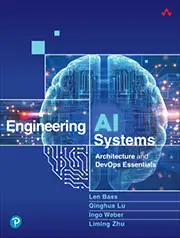
عنوان:
Engineering AI Systems
نویسنده:
Len Bass; Qinghua Lu; Ingo Weber; Liming Zhu
انتشارات:
Addison-Wesley
تاریخ انتشار
2025
حجم:
7.1MB
معرفی کتاب: " مهندسی سیستمهای هوش مصنوعی: معماری و اصول اساسی DevOps "
در دنیای پرشتاب فناوری، ادغام هوش مصنوعی دیگر یک انتخاب نیست بلکه یک ضرورت استراتژیک است. کتاب Engineering AI Systems یک راهنمای جامع و کاربردی برای مهندسین نرمافزار، معماران سیستم، و توسعهدهندگانی است که میخواهند سیستمهای AI را مقیاسپذیر، قابلاعتماد و ایمن طراحی و پیادهسازی کنند.
نویسندگان:
Len Bass، Qinghua Lu، Ingo Weber و Liming Zhu — از پژوهشگران و متخصصان برجسته مهندسی نرمافزار و AI — در این کتاب، چالشها و بهترین شیوههای ادغام هوش مصنوعی در سیستمهای واقعی را بررسی و راهکارهای عملی ارائه میکنند.
آنچه در این کتاب میآموزید:
- ✓ مدیریت چرخه عمر مدلهای AI؛ از آمادهسازی دادهها تا استقرار در محیط عملیاتی
- ✓ بهکارگیری اصول معماری نرمافزار و DevOps برای پروژههای AI
- ✓ تضمین امنیت، قابلیت اطمینان و عملکرد سیستمهای هوش مصنوعی
- ✓ رعایت حریم خصوصی، عدالت الگوریتمی و الزامات قانونی برای افزایش اعتماد
- ✓ استفاده از نظارت و مشاهدهپذیری (Observability) جهت حفظ کیفیت و کنترل عملیاتی
- ✓ شناخت روندهای آینده در مهندسی AI برای حفظ مزیت رقابتی
این کتاب برای چه کسانی مناسب است؟
- ✓ معماران نرمافزار که به دنبال طراحی زیرساختهای AI مقاوم هستند
- ✓ توسعهدهندگان و مهندسان ML که با چالشهای استقرار مدلها در دنیای واقعی روبهرو هستند
- ✓ مدیران فناوری و استراتژیستهای دیجیتال که میخواهند پروژههای AI را در سطح سازمانی اجرا کنند
اگر به دنبال ساختن زیرساختهای آیندهنگر برای هوش مصنوعی هستید، این کتاب یکی از منابع کلیدی شما خواهد بود.
فهرست مطالب
- Cover Page
- About This eBook
- Title Page
- Copyright Page
- Contents
- Preface
- Acknowledgments
- About the Authors
- 1. Introduction
- 1.1 What We Talk about When We Talk about Things: Terminology
- 1.2 Achieving System Qualities
- 1.3 Life-Cycle Processes
- 1.4 Software Architecture
- 1.5 AI Model Quality
- 1.6 Dealing with Uncertainty
- 1.7 Summary
- 1.8 Discussion Questions
- 1.9 For Further Reading
- 2. Software Engineering Background
- 2.1 Distributed Computing
- 2.2 DevOps Background
- 2.3 MLOps Background
- 2.4 Summary
- 2.5 Discussion Questions
- 2.6 For Further Reading
- 3. AI Background
- 3.1 Terminology
- 3.2 Selecting a Model
- 3.3 Preparing the Model for Training
- 3.4 Summary
- 3.5 Discussion Questions
- 3.6 For Further Reading
- 4. Foundation Models
- 4.1 Foundation Models
- 4.2 Transformer Architecture
- 4.3 Alternatives in FM Architectures
- 4.4 Customizing FMs
- 4.5 Designing a System Using FMs
- 4.6 Maturity of FMs and Organizations
- 4.7 Challenges of FMs
- 4.8 Summary
- 4.9 Discussion Questions
- 4.10 For Further Reading
- 5. AI Model Life Cycle
- 5.1 Developing the Model
- 5.2 Building the Model
- 5.3 Testing the Model
- 5.4 Release
- 5.5 Summary
- 5.6 Discussion Questions
- 5.7 For Further Reading
- 6. System Life Cycle
- 6.1 Design
- 6.2 Developing Non-AI Modules
- 6.3 Build
- 6.4 Test
- 6.5 Release and Deploy
- 6.6 Operate, Monitor, and Analyze
- 6.7 Summary
- 6.8 Discussion Questions
- 6.9 For Further Reading
- 7. Reliability
- 7.1 Fundamental Concepts
- 7.2 Preventing Faults
- 7.3 Detecting Faults
- 7.4 Recovering from Faults
- 7.5 Summary
- 7.6 Discussion Questions
- 7.7 For Further Reading
- 8. Performance
- 8.1 Efficiency
- 8.2 Accuracy
- 8.3 Summary
- 8.4 Discussion Questions
- 8.5 For Further Reading
- 9. Security
- 9.1 Fundamental Concepts
- 9.2 Approaches to Mitigating Security Concerns
- 9.3 Summary
- 9.4 Discussion Questions
- 9.5 For Further Reading
- 10. Privacy and Fairness
- 10.1 Privacy in AI Systems
- 10.2 Fairness in AI Systems
- 10.3 Achieving Privacy
- 10.4 Achieving Fairness
- 10.5 Summary
- 10.6 Discussion Questions
- 10.7 For Further Reading
- 11. Observability
- 11.1 Fundamental Concepts
- 11.2 Evolving from Monitorability to Observability
- 11.3 Approaches for Enhancing Observability
- 11.4 Summary
- 11.5 Discussion Questions
- 11.6 For Further Reading
- 12. The Fraunhofer Case Study
- 12.1 The Problem Context
- 12.2 Case Study Description and Setup
- 12.3 Summary
- 12.4 Takeaways
- 12.5 Discussion Questions
- 12.6 For Further Reading
- 13. The ARM Hub Case Study
- 13.1 Introduction
- 13.2 Our Approach
- 13.3 LLMs in SME Manufacturing
- 13.4 A RAG-Based Chatbot for SME Manufacturing
- 13.5 Architecture of the ARM Hub Chatbot
- 13.6 MLOps in ARM Hub
- 13.7 Ongoing Work
- 13.8 Summary
- 13.9 Takeaways
- 13.10 Discussion Questions
- 13.11 For Further Reading
- 14. The Banking Case Study
- 14.1 Customer Churn Prediction
- 14.2 Key Challenges in the Banking Sector
- 14.3 Summary
- 14.4 Takeaways
- 14.5 Discussion Questions
- 14.6 For Further Reading
- 15. The Future of AI Engineering
- 15.1 The Shift to DevOps 2.0
- 15.2 AI’s Implications for the Future
- 15.3 AIWare or AI-as-Software
- 15.4 Trust in AI and the Role of Human Engineers
- 15.5 Summary
- 15.6 Discussion Questions
- 15.7 For Further Reading
- References
- Index
مشخصات
نام کتاب
Engineering AI Systems
نویسنده
Len Bass; Qinghua Lu; Ingo Weber; Liming Zhu
انتشارات
Addison-Wesley
تاریخ انتشار
2025
ISBN
9780138261450
تعداد صفحات
613
زبان
انگلیسی
فرمت
حجم
7.1MB
موضوع
Artificial Intelligence
